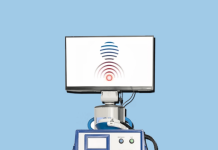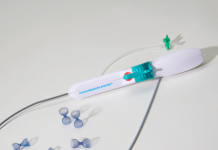For those suffering from neurological or severe psychiatric disorders, neurostimulation therapy can be a promising avenue for treatment. This therapy relies on the use of neurostimulation devices, which apply energy to neurons in the brain to encourage them to grow or make new connections.
Epilepsy treatment is one common application for neurostimulation devices, though similar treatment can also be used for Parkinson’s disease, chronic pain and psychiatric disorders, such as depression.
Now, researchers at the Univesity of Minnesota have developed a new neurostimulation device – the MagPatch – that is capable of single-neuron precision. This extra precision could be highly beneficial for future cochlear implants or vagus nerve stimulators, the researchers say. A research paper demonstrating the use of the prototype MagPatch on human neuroblastoma cells is published in the Journal of Vacuum Science & Technology B.
While there are already several neurostimulation devices and treatments that have received approval from the US Food and Drug Administration (FDA) to be used on patients, these devices have a rather large effect range.
“The motivation behind this study originated when the National Institute of Health (NIH) released a call for proposals on designing and fabricating stimulator devices for cellular-level interventions,” said lead study author Renata Saha. Now a senior scientist at DuPont, Saha was a MnDRIVE neuromodulation fellow at the University of Minnesota during this research.
“There are several neurostimulation devices in the market – some were already FDA approved for patient trials, some were pending approvals. But each of them had one caveat – they stimulated a large population of neurons, including neighboring cells that weren’t supposed to be stimulated,” Saha explained.
Around the same time as the NIH call for proposals, Saha and her team at the University of Minnesota Department of Electrical and Computer Engineering were already actively developing new neurostimulation technologies using microscopically-sized magnetic coils, or microcoils, that promised to deliver a more precise effect.
“Our preliminary animal studies had already shown that micromagnetic stimulation is highly directional in nature,” Saha said. “We planned on exploiting this highly directional nature of the induced electric field from these microcoils to use it for cellular-level neuron stimulation. This particular thought laid the foundations of the design, fabrication and testing of the MagPatch array reported in this work.”
The MagPatch is an array of eight magnetic microcoils that use electric current to create a magnetic field powerful enough to affect nearby neurons.
“Essentially, the devices in MagPatch are micrometer-sized coils or microcoils that can be implanted in the brain or in the periphery of a nerve and operate based on a physics law taught in high school – Faraday’s laws of electromagnetic induction,” Saha explained. “Upon applying a time-varying current through these microcoils, they generate a time-varying magnetic field, which generates an induced electric field that stimulates the neurons.”
In addition to being much more precise than the traditional electrodes used in other neurostimulation systems, the implantable MagPatch is also designed to function for longer without degradation.
“This induced electric field is not in direct galvanic contact with the neurons,” Saha said. “Hence, there is less biofouling effect from the adjacent neurons and supporting cells causing the electrodes to degrade significantly less.”
But making the MagPatch was not without its challenges. One of the reasons that the patch consists of eight microcoils instead of just one, is that the amount of current needed to drive these microcoils is extremely high. By increasing the number of microcoils in use, the researchers were able to induce magnetic fields using significantly less current per coil.
To further improve the efficiency of their device, the researchers also added certain soft magnetic materials to the core of the microcoils.
“A more effective way for reducing the power of driving these microcoils is to use soft magnetic materials (SMM) at the core of these microcoils in the array,” Saha explained. “Adding these SMM materials at the core of these microcoils increases the [strength of the] electric field without increasing the current that is required to drive these microcoils.”
To demonstrate the effectiveness of the MagPatch, Saha and her team created a prototype of the device primarily using titanium, gold and silicon nitride – all materials that are already commonly used in medical implants. To improve the device’s biocompatibility even further, it was also encased in a watertight biocompatible coating of parylene-C polymer.
They tested the device using human neuroblastoma cells, finding that the MagPatch was able to stimulate the cells without harming them, suggesting the device could be safe for future clinical use.
“By fabricating a proof-of-concept prototype for such an array and encapsulating it in a biocompatible coating, we were successful in adhering human neuroblastoma cells to that coating,” Saha said. “When the adhered cells responded to the stimulation applied to those cells, we confirmed that the cells adhering to the fabricated prototype were alive. This implied the preliminary biocompatibility of the MagPatch devices.”
Following the success of the prototype, the researchers say they plan to continue developing the MagPatch device to further explore its safety and utility. Such a device could help to improve future generations of cochlear implants, they suggest, or neural stimulation technologies that more selectively target the vagus nerve.






